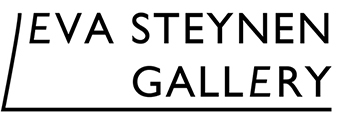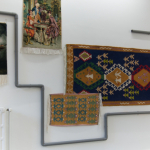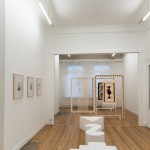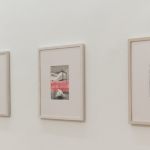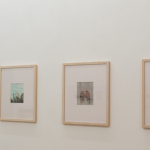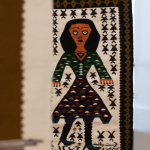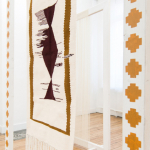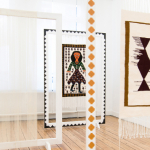GOLNESA REZANEZHAD
Weaving the past into the future
21.01 - 02.03.2024
Eva Steynen Gallery is delighted to present 'Weaving the past into the present' a solo exhibition by the Iranian artist and researcher Golnesa Rezanezhad (°1982, IRN works and lives in Ghent). The exhibition evolves from an ongoing research-based artistic practice that Rezanezhad started in 2016. It explores how female rug and carpet weavers in Iran reflect on their womanhood and their agency to express through their design and the act of traditional hand weaving.
On view are different installations integrating rug tapestries and works on paper. Centrally we see a triptych of human-sized looms. In this installation the works are shaped in response to each-other. By the combination of a figurative work, made by one of the local Iranian weavers, and an abstract work, designed by Rezanezhad and reflecting her interpretation of the female weavers' works. These abstract patterns are based on the figurative motifs used in northern Iran. Rezanezhad's rugs don't analyze the work of these weavers, but her goal is to provide more visibility to their rugs’ visual communication. Therefore she added an empty loom, to convey an ongoing space for improvisation and cultural transformation.
Rezanezhad considers the art practice to be a collaborative process. The exhibition shows different types of collaboration with female rug-weavers in northern Iran. The collaborative design and weaving with artisans is based on reflecting their own everyday life stories by transforming traditional motifs. Rezanezhad's own designs are inspired by the initial motifs she found woven by local artisans in two villages in northern Iran. In her drawings and installations, figures referring to caring, family, community and nature stand in contrast with symbols of a 'masculine' petroleum-based economy, represented by oil-pipes and industrial related tools.
Rezanezhad, descends from a family of female weavers: “I am a third generation after my grandmother who visioned another future for her daughters and granddaughters, rather than what she lived, produced and created. She was born during the Reza Shah Pahlavi and lived the second Pahlavi time and Islamic Republic time. When she was born, modernization boomed in Iran and many socio-political shifted alongside new visions created among women who were an important target group during the Shah's modernization. I began to think about this project when I started to be more conscious about my feeling of being suspended in the time, the feeling of rapture between the present and the past ”
Rugs and carpet weaving have been Iran’s main export products. Especially in the pre-oil economy, the craft of hand-weaving was done by women. In the general opinion the embodied practice of weaving is considered to be a form of being that relates to the past. In this present time, however, Rezanez shows us that weaving has been reinvented in contemporary times as an artistic skill for reflecting artisans’ desired aesthetics and perceptions.
Exhibition views
Q&A with Golnesa Rezanezhad.
Can you tell us about the project 'Weaving the past into the present?
The exhibition results from a research-based artistic practice between 2016-2022 in northern Iran. It shows how the female rug and carpet weavers imagine their womanhood through the act of traditional hand weaving and reflect their imaginations on their rugs' motifs.
The weaving threads and rugs serve as poignant symbols, embodying feminine caring narratives about family, community and nature amidst this dynamic interplay. They stand in stark contrast to the symbolism of modernization, and masculine economy, epitomized by the (oil) pipe.
The act of weaving and these textiles serve as metaphors for cultural practices ingrained within specific geographies, reflecting and often shaping everyday gender roles and performances. The practice and woven rugs serve as a lens through which to examine the embodiment and evolution of past practices within modernized Iran. They stand resilient against transnational influences, yet remain susceptible to transformation within evolving cultural paradigms.
It intricately weaves together a narrative of continuation, improvisation, and transformation of cultural heritage, gender roles, and economic bases in a country like Iran. Moreover, this exploration sheds light on the intersection of these cultural elements with economic structures. Particularly in oil-based economies prevalent in many Middle Eastern countries, it challenges the traditional roles of women, presenting a dynamic landscape where these roles are constantly renegotiated.
Central in your exhibition in the gallery will stand a triptych of looms presenting tree different rugs, one figurative, one abstract and one 'empty'. Can you explain us more about this installation?
This triptych is shaped by the combination of the local artisan’s self-initiative works and my own interpretation of their work reflected on my own designed rugs. My abstract pattern is improvised based on their figurative motifs. My rugs do not want to deconstruct their work, rather my works provide more visibility for their rugs’ visual communication.
The frames/looms that the rugs are installed on are patterned. The patterns are traditional geometric patterns taken from the background or margin of the artisans’ rugs. There are empty looms between the artisans’ works and my improvisations based on their work. These empty looms convey an ongoing space for cultural improvisation and transformation.
How did you make the collaborative work with women in Iran?
With women, weavers in two villages, Ravane Sadri in Anbaran and Parvin Hosseini in Sakineh Abaad villages, and in the city of Rasht (I worked with a group of women whose names are referenced in the exhibition booklet and beside the works) all located in northern Iran.
The wall installation shows rugs and pipes around the rugs.
The pipe installation is inspired by the idea of the oil-based economy in Iran which transformed the hand-made craft-based economy on the one hand and on the other hand, it conveys all the modernized infrastructures that have transformed the concept of womanhood among Iranian women and the weavers.
In this installation, there are two types of rugs, two of them were shaped by a collaborative design and woven by the artisans and I.
In the local rug weavers' collaboration, I transformed the traditional flora motifs into the motifs of human bodies.
The newly designed motifs are shaped based on the stories that the participants shared about their gendered roles and their relation to the current social environment.
Two other exhibited works are knotted carpets, which technically are different from the rugs on the floors. These decorative carpets are woven by weavers in Iran. These patterns are very prevalent in the Iranian market and decorate the middle-class population’s interiors.
While the first rugs are inspired by individual and collective stories of participants, the second type reflects the imagination of weavers and middle-class Iranians around gender and womanhood.
What are the drawings you present and what are they referring to?
The drawings depict the evolution also driven by the transition from agricultural and craft-based economies to oil-based economies, signifying the profound impact on multiple aspects of everyday life, encompassing both people and nature. Within this transformation, women's roles and their daily practices are significantly influenced and challenged.
This exhibition is part of ongoing project?
The project 'Weaving the past into the present' is evolving, not necessarily focused solely on rug weaving, but rather on exploring the relationship between crafting and its connection with nature. It delves into the interconnection between economic foundations and our relationship with nature and whole world beyond the borders.
°°The solo exhibition runs in collaboration with Kunsthal Extra City, where a second triptych of rugs are part of the exhibition 'Carpetland, critical tapestries' , on view until 14 April 2024.°°
***
PRESS: GLEAN MAGAZINE 07.02.2024

